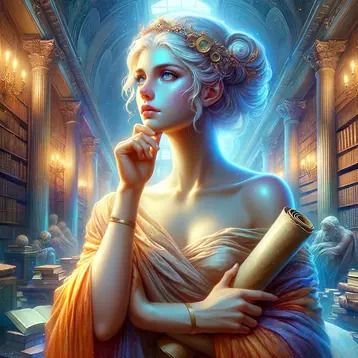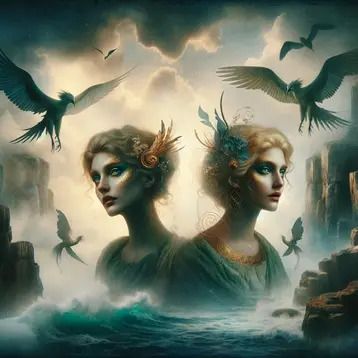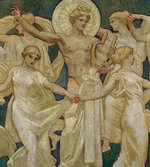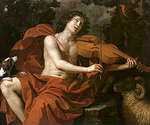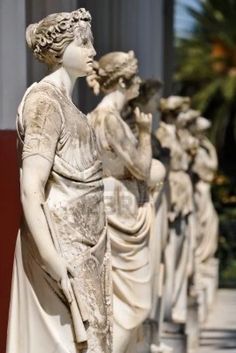
The Muses
The Muses :: Goddesses of Music, Poetry & Arts
The Muses were the Greek goddesses of poetic inspiration, the adored deities of song, dance, and memory, on whose mercy the creativity, wisdom and insight of all artists and thinkers depended. They may have been originally three in number, but, according to Hesiod and the prevailing tradition he established, most commonly they are depicted as the nine daughters of Zeus and Mnemosyne.
Family and Dwelling Places
Hesiod says that the Muses were daughters of Zeus and the Titaness Mnemosyne, the Goddess of Memory; most authors seem to agree with him. However, two ancient lyric poets, claim otherwise: according to Theognis, their father was indeed Zeus, but their mother was actually Harmonia, while according to Alcman, the Muses were, in fact, daughters of Uranus and Gaea. Some later authors have even tried to reconcile the stories, proposing two different generations of Muses.
Most commonly, it was thought that the Muses were born in Pieria at the foot of Mount Olympus, so they were often called either Olympian or Pierian Muses. However, Mount Helicon in Boeotia was a place they certainly held dear to their hearts, since it was here that Hesiod met them and was inspired by them to write “The Theogony.” Unsurprisingly, they are referred to as “Heliconian Muses” in the first verse of that glorious poem.
Number, Names, Attributes, and Domains
Depending on the region where they were celebrated, both the names and the number of Muses varied. There are various accounts of five, seven and even eight Muses. However, they are most often either three (probably in earlier reports) or nine (following Hesiod and maybe Homer).
The Three Muses
At both Delphi and Sicyon, there were no more than three Muses. According to Plutarch, one of the Sicyonian Muses was called Polymatheia, or “The One of Much Learning.” Pausanias, a Greek geographer from the second century, claims that there were originally three Heliconian Muses as well. However, the names he cites for them – Melete (“Study”), Mneme (“Memory”), and Aoide (“Song”) – sound too modern to believe him.
The Nine Muses
In “The Theogony,” Hesiod tells us that there were nine Muses – and most authors, especially since Roman times, abide by his account. The Greek epic poet gives a meaningful name to each of these nine Muses, but we don’t know whether he had intended a different office for all of them. Later poets, however, used the Hesiodic names as a foundation for further differentiation, so they distributed the Muses among diverse realms, attaching to each of them different attributes and powers. Here’s a tentative list:
• Thalia (“The Cheerful One”) was the Muse of Comedy and was often portrayed holding a comic mask or a shepherd’s crook;
• Urania (“The Heavenly One”) was the Muse of Astronomy, and you can often see her holding a globe;
• Melpomene (“She Who Sings”) was the Muse of Tragedy, and she is either holding a tragic mask or some other symbol of tragedy (sword, club, buskins);
• Polyhymnia (“She of the Many Hymns”) was the Muse of Hymns and sacred poetry, often depicted with a pensive look hidden behind a veil;
• Erato (“The Lovely One”) was the Muse of Lyric Poetry; naturally, she’s usually represented with a lyre;
• Calliope (“The One with a Beautiful Voice”) was the Muse of Epic Poetry; Hesiod claims that she was the foremost among the nine, since “she attends on worshipful princes”; Calliope can often be seen holding a writing tablet;
• Clio (“The Celebrator,” “The Proclaimer”) was the Muse of History, and, quite fittingly, she usually holds a scroll;
• Euterpe (“She Who Pleases”), was the Muse of Flute-playing, which is why she is time and again portrayed with an aulos;
• Terpsichore (“The One Delighting in the Dance”), was the Muse of Choral Lyric and Dancing; as expected, she is usually shown dancing and sometimes holding a lyre.
The order in which we presented the Muses here is not the order they are usually given in. However, we chose it for a reason: in this order, the initials of the Muses form an acronym (“TUM PECCET”) which students used for many centuries to remember the names of the goddesses. Interestingly, “Tum peccet” means something along the lines of the playfully ironic “Well, try to forget now!” – which fits perfectly with the role of the Muses as memorizers and the function of the mnemonic device itself!
The Muses in Particular Myths
Other than divine inspirers in the verses of the poets, the Muses appear rarely in myths; and when they do, they are usually much less gentle revelers than diving avengers.
Revelers
Presided over by Apollo, the Muses spent much of their time on Olympus cheerfully singing and dancing at the feasts of the gods. Sometimes they also came down to earth, so as to either mourn a funeral (like that of Achilles) or celebrate a marriage (like those of Peleus to Thetis and Cadmus to Harmonia).
Avengers
Protective of their status, the Muses were not above punishing anyone who dared to challenge their skill.
For example, Thamyris, a Thracian bard, was blinded and robbed from his talents when he boasted that he’s a better musician than them. Demodocus, a Phaeacian bard who appears in Homer’s “Odyssey,” had his eyes plucked out by the Muses as well, but Homer says that, as a compensation, he got the gift of sweetest song.
Once Hera persuaded the Sirens to challenge the Muses, but, unsurprisingly, they lost to them as well, and the Muses made themselves crowns from the Sirens’ feathers. Finally, the Macedonian king Pierus dared the Muses to a contest against his nine daughters, who, after their defeat, were transformed into prattling magpies.
The Sons of the Muses
Even though usually described as virgin goddesses, the Muses seemed like the perfect candidates for mothers of few mythical musicians and dancers.
Consequently, Orpheus was often identified as the son of Calliope, as were sometimes the Sirens, who were more commonly linked to either Terpsichore or Melpomene. Linus, the great musician and orator of Thrace, was fathered by Apollo with either Calliope or Urania, and the Corybantes were usually described as sons of Thalia.
In addition, Hyacinthus was thought of as the son of Clio, and Rhesus as the son of either Calliope or Euterpe.
The Muses Sources
Read the first hundred or so verses of Hesiod’s “Theogony,” where the poet eloquently invokes the Heliconian Muses. In the first four sections of the first book’s third chapter of Apollodorus’ “Library,” there’s an excellent summary of the most important myths related to the Muses and their offspring.
The Muses Video
The Muses Q&A
Link/Cite The Muses Page
Written by: The Editors of GreekMythology.com. GreekMythology.com editors write, review and revise subject areas in which they have extensive knowledge based on their working experience or advanced studies.
For MLA style citation use: GreekMythology.com, The Editors of Website. "The Muses". GreekMythology.com Website, 12 Dec. 2022, https://www.greekmythology.com/Other_Gods/The_Muses/the_muses.html. Accessed 26 April 2024.

